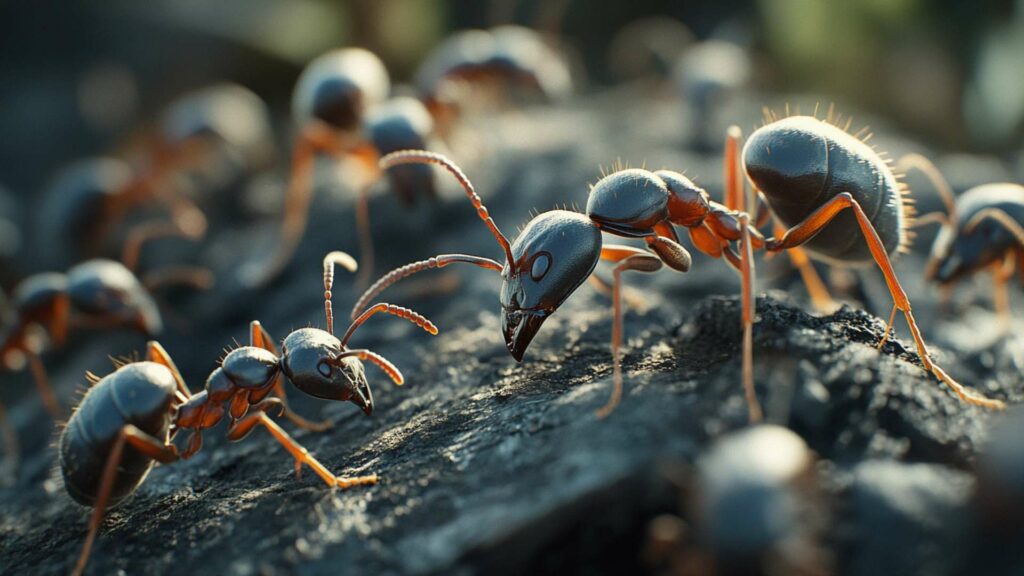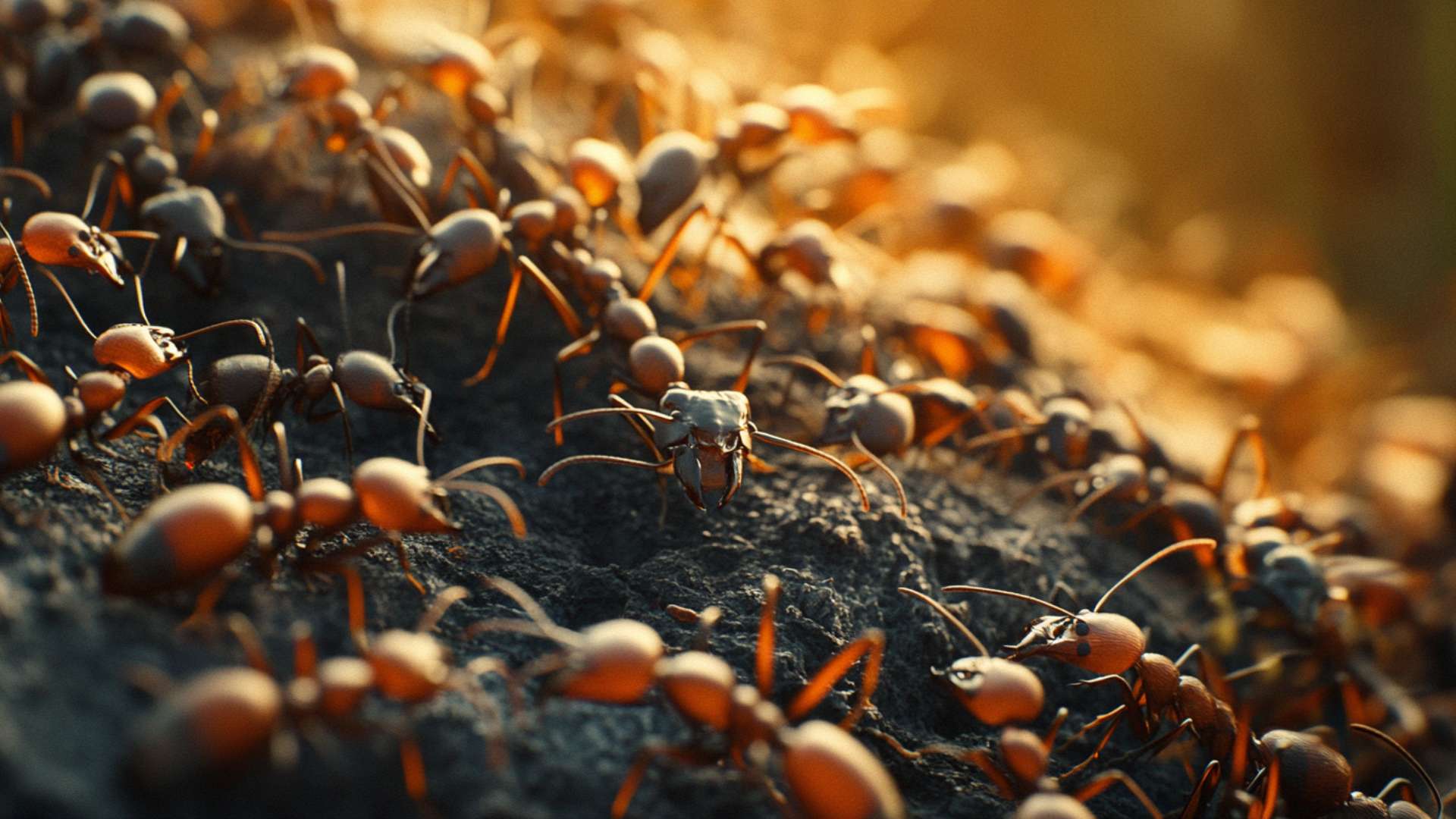Ants, those tiny six-legged creatures, and other pests have long plagued homeowners with their persistent presence. They are among the most common household pests, infiltrating our homes in search of food and water.
These industrious insects can be found scurrying across kitchen countertops, invading pantries, and forming long trails along walls. What makes ants particularly troublesome is their ability to colonize quickly and establish large networks that are challenging to eradicate.
When it comes to ants, there isn’t just one species causing havoc in homes; rather, there are numerous ant species that can infest residential areas. Some of the most common culprits include pavement ants, pharaoh ant poison, ants, and carpenter ants.
Each type has unique characteristics and preferences when it comes to invading your humble abode. While some ants are merely a nuisance with their marching lines, others like carpenter ants can cause structural damage by tunneling through wood.
Explanation of Why Ants Invade Homes

Have you ever wondered why these tiny invaders make your home their playground? Well, the answer lies in their basic needs: food, water, and shelter. Like any living creature on this planet (except maybe for some extraterrestrial beings), ants require sustenance to survive.
They have a keen sense of smell that allows them to pick up even minute traces of food odor—whether it’s crumbs on your kitchen floor or leftovers inside your indoor trash cans. Apart from pepper ants being attracted by readily-available food sources within our homes like unsealed snacks or pet food left out overnight, many ant species also possess a sweet tooth.
They have a particular affinity for sugar-rich substances and may go to great lengths just to get a taste. This is why spilled soda or sticky spills can quickly become an ant magnet.
In addition, ants want access to food, ants also need water to quench their thirst. They can detect even the tiniest droplets, often leading them to damp areas like leaky pipes or condensation on kitchen surfaces.
Moreover, some ant species seek shelter within homes to establish their colonies comfortably. Cracks in walls, gaps around windows and doors, or even unsealed entry points become gateways for these tiny intruders.
Understanding why ants invade our homes is crucial for effectively combatting them. By addressing the root causes of their attraction—food availability, water sources, and entry points—we can better prevent infestations and protect our homes from these persistent pests.
Understanding Ant Behavior and Biology
Different Types of Ants Commonly Found in Homes
Ants are incredibly diverse creatures, and it’s no surprise that there are several types commonly found infiltrating our homes. One of the most prevalent species is the pavement ant (Tetramorium caespitum), known for its light to dark brown in color and propensity for nesting under sidewalks or pavements.
Another common culprit is the odorous house ant (Tapinoma sessile), which emits a distinct smell when crushed, resembling that of rotten coconut. Additionally, we often come across harvester ants (Pogonomyrmex sp.), which tend to invade kitchens in search of sugary treats and are recognizable by their reddish-brown hue.
How Ants Communicate and Establish Their Colonies
Ants have developed sophisticated communication systems to coordinate their activities within colonies. They primarily rely on chemical signals called pheromones, which they leave behind as they move around.
These pheromones act as chemical trails that guide other ants to food sources or help them locate nest entrances. This communication method allows ants to navigate efficiently in search of resources such as water or food.
When establishing colonies, ant queens play a pivotal role. A queen mates with males before finding a suitable nest location where she lays her eggs.
As the first brood emerges, these worker ants take on various responsibilities such as foraging, caring for larvae, or defending the colony from threats. The population kills ants gradually grows as new workers mature and contribute to the functioning of the colony.
Seasonal Patterns of Ant Activity
Ant activity can vary depending on the season, influenced by factors such as temperature and resource availability. In warm spring months, ant colonies become more active as they emerge from hibernation or seek new nesting sites. As summer arrives, ants intensify their foraging efforts and often infiltrate households in search of sweet or protein-rich foods.
The fall season brings a shift in behavior, with ants focusing on storing food reserves for the approaching winter. During winter, ant activity decreases significantly as colonies enter a state of dormancy to conserve energy until the warmer months return.
Understanding these seasonal patterns can help us anticipate ant infestations and take preventative measures accordingly. By staying vigilant during peak seasons of activity, we can proactively protect our homes from these persistent pests.
Prevention is key: Keeping ants out
Identifying and sealing entry points for ants
To effectively keep ants out of your home, it’s essential to identify their entry points. These tiny creatures can squeeze through even the tiniest cracks and crevices. Inspect your home carefully, paying close attention to areas where you’ve noticed ant trails or where they seem to congregate.
Common entry points include gaps around windows and doors, cracks in the foundation, and utility lines entering your home. Use caulk or weatherstripping to seal these openings and prevent future ant invasions.
Proper food storage and waste management practices

Ants are relentless in their pursuit of food, so it’s crucial to deprive them of any temptations. Practice proper food storage by keeping all pantry items tightly sealed in airtight containers.
Avoid leaving ripe fruit on countertops as it attracts not only ants but also other insects. Additionally, promptly clean up any food spills or crumbs on your kitchen surfaces and floors, as even the tiniest morsels can entice hungry ants into your home.
Maintaining a clean and tidy home environment
A clean living space not only promotes good hygiene but also helps deter ants from infesting your home. Regularly sweep or vacuum floors to remove any stray food particles that may have escaped notice. Wipe down kitchen countertops with a mixture of water and dish soap—this not only cleans the surface but also eradicates scent trails left behind by foraging ants.
It’s also important to keep garbage cans tightly sealed and take out trash regularly to prevent odors that attract pests. By implementing these prevention measures consistently, you can significantly reduce the chances of an ant invasion in your home.
Remember that prevention is an ongoing process – vigilance is key! (Note: These tips are effective for most ants commonly found in homes. If you’re dealing with specific ant species like harvester ants or carpenter ants, you may need to employ additional strategies or seek professional assistance.)
Natural Remedies to Deter Ants
Using Vinegar, Lemon Juice, or Essential Oils as Deterrents
When it comes to naturally deterring ants from invading your home, vinegar, lemon juice, and essential oils can be incredibly effective. These common household pest repellents and ingredients have strong scents that ants dislike, which can disrupt their ability to communicate and locate food sources. To create a homemade ant repellent spray, mix equal parts water and vinegar or lemon juice in a spray bottle.
Shake it well and then spray it along the areas where you often see ants crawling insects or trailing. You can also add a few drops of essential oils like peppermint or tea tree oil to the mixture for an extra potent scent deterrent.
Sprinkling Diatomaceous Earth or Cinnamon Near Entry Points
Another natural approach to deterring ants is by using diatomaceous earth or cinnamon powder near entry points. Diatomaceous earth is a fine powder made from fossilized remains of marine phytoplankton. It acts as tiny shards that pierce through the exoskeleton of insects like ants, causing them to dehydrate and die.
Simply sprinkle a line of diatomaceous earth along windowsills, doorways, or any other areas where ants are gaining access into your home. Cinnamon powder also works wonders as an ant deterrent due to its strong scent that repels them.
Sprinkle ground cinnamon around entry points or trails where you’ve noticed ant activity in your home. This will create an invisible barrier that ants are reluctant to cross.
Planting Ant-Repellent Herbs in Your Garden or Windowsill
Nature provides us with several herbs that can help keep ants at bay while adding beauty and fragrance to our surroundings. Mint plants such as spearmint or peppermint are excellent natural ant repellents since their strong scent overpowers the pheromones ants use to communicate.
Planting them around your windowsill or in your garden can create a barrier that attracts ants that will be less likely to cross. Another herb that acts as an ant deterrent is lavender.
Not only does it smell delightful, but ants find its fragrance repulsive. Planting lavender near entry points or keeping dried lavender sachets in cupboards and drawers can help prevent ants from establishing a foothold in your home.
Remember, while these natural remedies can help deter ants, they may not eliminate an existing ant problem entirely. They work best as preventive measures or as part of a comprehensive approach to controlling ant infestations.
Homemade Ant Baits and Traps for Elimination
Borax-based Bait Recipes to Target Entire Colonies
If you’re dealing with a persistent ant infestation, it’s time to bring out the big guns – borax-based ant baits. Borax is a naturally occurring mineral that is lethal to ants when ingested. To create an effective bait, combine equal parts of borax and something sweet like sugar or honey.
The sugar acts as an enticing attractant while the borax delivers a fatal blow. To make the bait, mix one tablespoon of borax with one tablespoon of sugar or honey, then add just enough water to create a thick paste.
Place small amounts of this mixture on small pieces of cardboard or disposable lids near ant trails or entry points. The worker ants will eagerly carry it back to their nest and share it with the rest of their colony, effectively wiping them out.
Remember, patience is key here since it takes time for the bait to do its job. Resist the temptation to clean up the bait stations too soon – let all the ants have a chance to feast on these lethal treats and bring them back home.
Creating Simple DIY Traps Using Sugar or Honey as Bait
Another effective method for eliminating existing ants in your home is by setting up DIY ant traps using common household items like sugar or honey. These traps work by luring ants in with their sweet scent and then trapping them inside.
To make a simple sugar trap, mix two tablespoons of sugar with one tablespoon of water until you have a thick syrup-like consistency. Dip cotton balls into this mixture and place them near areas where you spot ant activity.
The sticky syrup will attract ants seeking a sugary feast, but once they’re trapped, they won’t be able to escape. Alternatively, you can use honey instead of sugar to create a similar trap.
Spread a thin layer of honey on small pieces of cardboard or disposable lids and place them strategically near ant trails or entry points. The ants will be enticed by the sweet aroma and become stuck in the sticky substance.
Regularly check and replace these traps as needed until you see a reduction in ant activity. Keep in mind that this method may not eliminate the entire colony, but it can significantly reduce their numbers over time.
Treating Outdoor Nests with a Mixture of Sugar and Boric Acid
Treating outdoor ant nests is vital for preventing future ants from invading your home. To deal with outdoor ants effectively, create a potent mixture using sugar and boric acid.
Mix one cup of sugar with one teaspoon of boric acid until it forms a granulated powder. Sprinkle this mixture around ants inside the outdoor ant nest and along their entrance trails.
The worker ants will be attracted to the sweet scent of the sugar while unknowingly carrying grains of boric acid back into their nest. Once inside the nest, the boric acid disrupts their metabolism and gradually eliminates them from within.
Be cautious when using this method near plants or areas where children or pets may come into contact with it, as boric acid can be harmful if ingested in large quantities. Remember that treating outdoor nests requires persistence since it may take several applications before all the ants are eradicated completely.
Professional Pest Control Options
Hiring a Licensed Exterminator for Severe Infestations
While DIY methods can be effective for minor ant problems, severe infestations often require the expertise of a licensed exterminator. Professional pest control technicians are equipped with specialized knowledge and tools to tackle stubborn ant colonies.
When the infestation becomes overwhelming and compromises your peace of mind, it’s time to call in the experts. Exterminators will conduct a thorough inspection of your home, identifying nest locations, entry points, and the ant species involved.
They will then employ targeted strategies tailored to deal with the specific type of ants infesting your home. This could involve using insecticides, baits, or even sealing off access points to ants permanently.
In cases where the source of the infestation is not clear or extends beyond your property boundaries (such as an outdoor nest), professional intervention becomes crucial. Licensed exterminators have access to stronger chemicals and tools that effectively eliminate ants while minimizing risks to humans and pets.
Exploring Non-Toxic Pest Control Methods
If you prefer environmentally friendly alternatives or have concerns about chemical treatments, there are non-toxic pest control methods available. These methods focus on repelling or killing ants, rather than killing them directly since they can be safe for both humans and beneficial insects like bees.
One approach is utilizing natural ant repellants such as peppermint oil or citrus fruits. The strong scents from these items disrupt ant trails and deter them from entering your home.
Simply apply a few drops of peppermint oil on cotton balls and place them near entry points or areas with high ant activity. Another effective non-toxic method involves creating homemade ant traps using simple household ingredients like maple syrup mixed with borax or baking soda.
The ants are attracted to the sweet smell of the syrup but are unaware they are ingesting a substance that will eventually kill them. It’s important to note that non-toxic methods may take longer to show results compared to chemical treatments.
Therefore, patience and consistency in reapplying these remedies are key for success. However, if you have concerns about the potential risks associated with chemical treatments or want to maintain an eco-friendly approach, exploring non-toxic pest control methods is an excellent option.
When faced with a severe ant infestation that DIY remedies cannot handle, hiring a licensed exterminator becomes necessary. They possess the expertise and tools to tackle even the most stubborn ant colonies effectively.
Alternatively, for those who prefer non-toxic solutions or want to minimize their environmental impact, exploring natural pest control methods can provide effective yet eco-friendly approaches to repel ants from your home. Remember, maintaining a clean environment and taking preventive measures are essential for long-term ant control success regardless of the method chosen.
Lesser-known tactics to combat ants
Using chalk lines or baby powder to disrupt ant trailsWhen it comes to outsmarting ants, sometimes the simplest tactics can yield surprising results. One such method involves using chalk lines or baby powder to disrupt their well-organized trail system. Ants rely heavily on pheromones to communicate and navigate, leaving invisible chemical trails for their fellow colony members to follow. By drawing a line of chalk or sprinkling baby powder across these trails, you effectively mask the scent and confuse the ants, making it harder for them to find their way back home. To apply this tactic, start by identifying the main ant trail in your home. This could be a line of marching ants leading from a crack in your kitchen counter straight towards that spilled food from yesterday’s cooking mishap. Take a piece of white chalk or a container of baby powder and draw a thick line across their path. Ensure that the line is unbroken and covers the entire trail. Remember to reapply the chalk or powder as needed, especially after cleaning or if it gets disturbed by foot traffic. While this method won’t kill ants directly, it disrupts their pathways significantly and forces them to search for alternative routes that may lead them away from your living space entirely.
Another lesser-known but effective tactic in combating ant infestations is utilizing nature’s own pest control agents: nematodes and ladybugs. Both these insects are natural predators of many garden pests, including ants. Nematodes are microscopic worms that can be purchased online or at gardening stores as a biocontrol agent against various pests, including odorous house ants or harvester ants. These beneficial organisms secrete bacteria that infect and kill insects while leaving plants unharmed. To use nematodes, mix them with water as per the package instructions and apply the solution to areas where you’ve observed ant activity or near their nests. Ladybugs, on the other hand, are well-known for their taste for aphids, but they also feed on ants. These adorable beetles can be ordered online or sometimes found at local garden centers. While introducing ladybugs into your home may not be feasible, releasing them in your garden or near ant colonies outside can help keep the ant population in check. Remember that introducing natural predators should be done strategically and with caution. Ensure that the predator species you choose is suitable for your region and won’t cause any harm to native ecosystems or become pests themselves. Both of these tactics offer environmentally friendly approaches to tackle an ant problem without resorting to harmful chemicals or pesticides. By disrupting ant trails and employing nature’s own pest control agents, you can add an extra layer of defense against those persistent little critters. While using chalk lines or baby powder to confuse ants and introducing natural predators like nematodes or ladybugs may not be the most commonly known methods for combating ant infestations, they can prove surprisingly effective. These tactics offer a non-toxic alternative worth considering if you’re looking for additional ways to get rid of ants naturally. Remember to combine them with other preventive measures mentioned earlier in this article for long-term success in keeping your home free from these pesky invaders.
Conclusion: Maintaining an Ant-Free Home Long-Term
A Recap of Prevention Strategies Discussed Earlier
To ensure your home remains ant-free in the long run, it’s crucial to implement the preventive measures we discussed earlier. Identifying and sealing entry points for common ants, such as cracks and gaps in walls or windows, is essential to keep ants from accessing your home.
Additionally, practicing proper food storage and waste management is vital to eliminate any attractive food sources for ants. Remember to keep your home clean and tidy, as even tiny crumbs can lure these persistent creatures.
Regular Monitoring and Prompt Action Against New Signs of Infestation
Even with the most thorough prevention strategies, occasional ant sightings may still occur. Therefore, it’s crucial to regularly monitor your surroundings for any signs of a new infestation. Keep an eye out for ant trails or clusters near windowsills, doors, or other potential entry points.
If you notice any signs of a new invasion of crazy ants, take immediate action before it escalates into a larger problem. When dealing with a new infestation, organic solutions like peppermint oil or citrus fruits can be effective in repelling ants.
Saturate cotton balls with these scents and place them strategically near their access points. Alternatively, create a solution by mixing water with a few drops of dish soap or essential oil; this will deter ants from venturing further into your home.
If you’re facing a more severe infestation that requires swift action, consider using ant traps or baits specifically designed for different ant species like fire ants or common household pests. These products contain substances that attract ants while effectively eliminating them at their source.
Additionally, if the problem persists despite your best efforts to control it yourself, hiring professional pest control services can provide reliable solutions tailored to your specific situation. Remember that maintaining an optimistic perspective is key when combating ant infestations.
With determination and the right strategies, you can regain control of your home and enjoy a peaceful, ant-free environment. By implementing preventive measures, regularly monitoring your surroundings, and taking prompt action when necessary, you will be well-equipped to keep all the ants at bay for good.
Keep in mind that natural solutions are not only effective but also eco-friendly. So take solace in the fact that as you repel ants from your home, you’re also protecting aquatic organisms called diatoms by not resorting to harmful chemicals.
Your efforts will pay off as you sip coffee in a peacefully ant-free kitchen or enjoy a meal without worrying about uninvited guests marching towards your pet’s food bowl. Embrace this journey towards an ant-free haven, knowing that by taking these steps today, you are securing a happier home tomorrow.
Dissuade Ants with D-Termination: Las Vegas’ Leading Pest Control Solution!

If you’re dealing with ant problems, D-Termination is your solution. Our proficient team specializes in deterring ants, rejuvenating cleanliness, and preserving the integrity of your area. Bid farewell to ants—opt for D-Termination for effective pest control today!
Reach out to us at 702-919-6310 or visit dtermination.com to schedule your ant control service and regain your space from these unwanted pests.
Frequently Asked Questions:
The fastest way to get rid of ants in your house is by using ant baits, sprays, or traps.
To stop ants from entering the house, seal cracks, keep food sealed, and maintain cleanliness.
Ants are typically attracted to food sources and moisture, which can lead them into the house.
Achieving permanent ant removal involves maintaining a clean environment and addressing entry points while using ant control methods.








